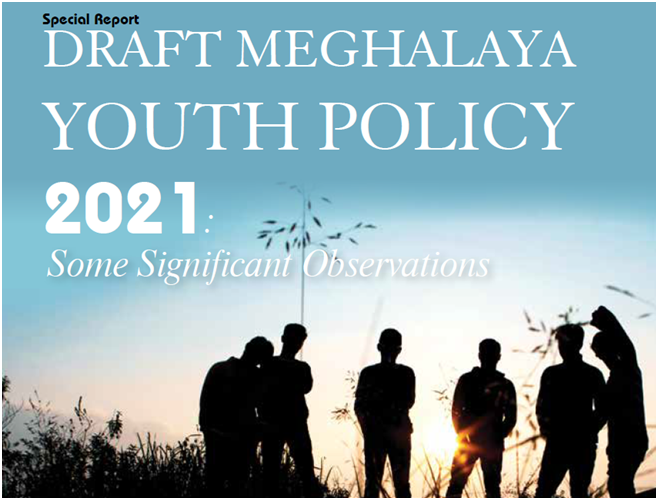
The Draft Meghalaya Youth Policy 2021 has been tabled by the Department of Sports and Youth Affairs, Government of Meghalaya. It is believed to have been drafted keeping in mind all stakeholders in the state striving towards the development and empowerment of the youth. The document has been developed after conducting consultation workshops and deliberation meetings with the Deputy Commissioners of various Districts, government departments which includes the Health and Family Welfare, Social Welfare, Education, Labour Department, Planning, Commerce and Industries, Arts and Culture, Tourism, Forest, Information Technology, and external agencies and bodies such as Indian Institute of Management, Rajiv Gandhi National Institute of Youth Development, Sriperumbudur, and Ernst and Young LLP.
While trying to understand the methodology followed in drafting this policy and the highlighted salient features, there are a few important observations that have been elaborated as follows.
- Youth’s involvement:
The draft policy stated to have included around 500 respondents (youth) between the age group of 15 to 29 years of age in a survey launched on the website of the Department of Sports and Youth Affairs, GoI. There are two questions that arise here; one, since the policy is for the youth of the State, has inputs from the youth between the same age group, representing all 11 districts been taken into consideration or is the 500 figure implying only youth from urban Shillongites. Secondly, the survey seemed to have missed including sections of youth who does not have adequate internet connectivity which has always been an issue in rural interiors.
In the above mentioned consultative meets, prominent youth organizations and youth clubs did not seem to surface in the list. Perhaps, it would have been preferred if collective inputs are taken from such groups, as they represent groups and subgroups that are not often in the limelight. While analyzing the existing population of the youth in the State, which constitutes 30.6 per cent, it would be difficult to understand the calculation/the proportion at which 500 was arrived at.
- Understanding youth:
The policy appears to have included a wide range of youth in the categories of those who are still studying and those who dropped out of their studies, youth from rural and urban Meghalaya, gender - male and female, youth from ethnic and religious minorities, socially and economically disadvantaged youth, differently able, vulnerable, and migrant/emigrant youths. In an era where advocacy and embracing the third gender has become imperative, we do hope that the policy will also include youth belonging to the third gender in all aspects of development initiatives.
The policy stressed enabling youth participation in all realms of personal and professional growth. A statement picked up from the State Vision says that ‘The State Youth Policy is an acknowledgement of the specific needs of young women and men, as well as a formal recognition of their unique contribution to State development’. This statement may seem too ambitious when compared to the ground reality of what our youth has been struggling to receive acknowledgement and financial help to represent the State in national and international platforms in the field of sports, performing arts (music, dance, acting, and artist) initiatives – big and small and others.
- Objectives of the policy:
The objectives of the policy are well-drafted and elaborative in nature. The point to promote a commitment in young people to protect ecology and the environment is much needed despite the fact that theoretically, they have learned Environmental Science (EVS as it is popularly known) from a very young age in their schools.
Another important objective is to make our young people economically self-reliant and productive members of society through access to holistic and quality education, training, skill and entrepreneurship development. Although this still remains a big challenge for our State and elsewhere in the country, the consistent efforts and initiatives of the State Government will one fine day bear fruits. Perhaps one aspect that needs deep contemplation is putting up strategies to avoid rural-urban migration amongst our youth. This can be explicitly done to reinforce identifying natural existing resources and reviving local traditional practices and livelihoods in rural interiors. Other than that entrepreneurship is well covered in the policy. The objective to revive indigenous games is an exciting one and the efforts in implementing such games which are becoming extinct will not be difficult.
The State’s Vision for the decade 2020-30 is to become one of the Top Ten States in the country is an excellent aim.
S Maxwell Lyngdoh
To read the further articles please get your copy of Eastern Panorama April issue @http://www.magzter.com/IN/Hill-Publications/Eastern-Panorama/News/ or mail to contact @easternpanorama.in


